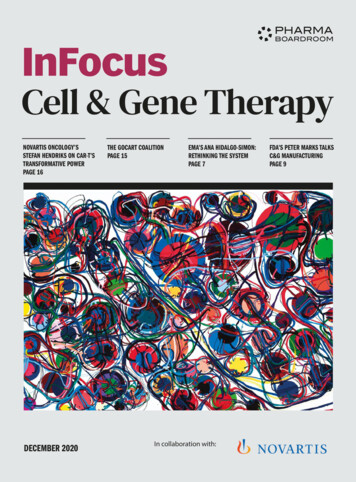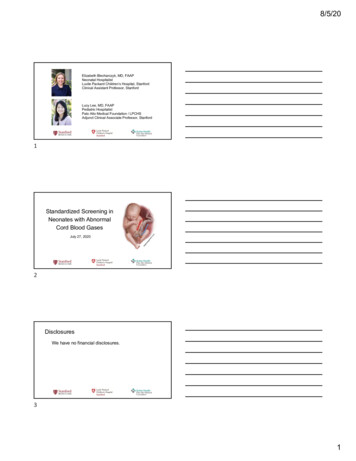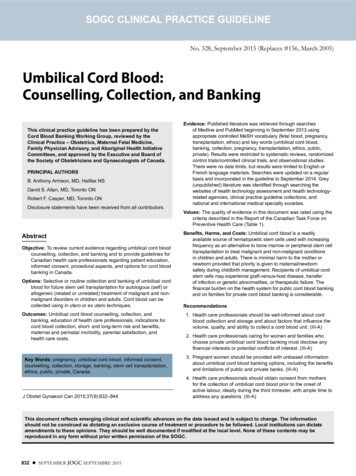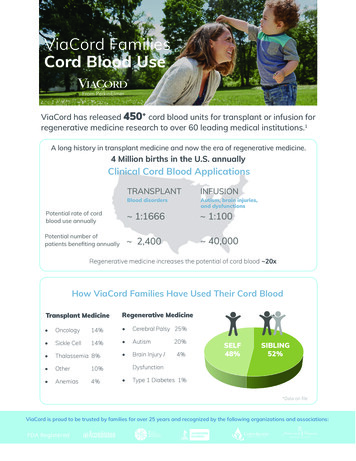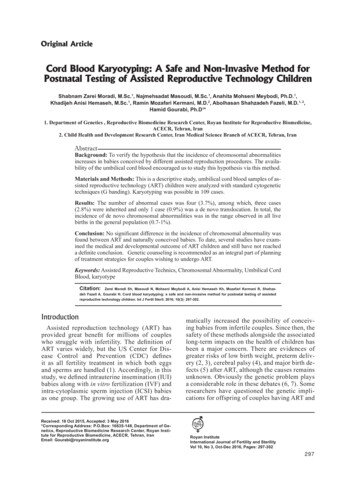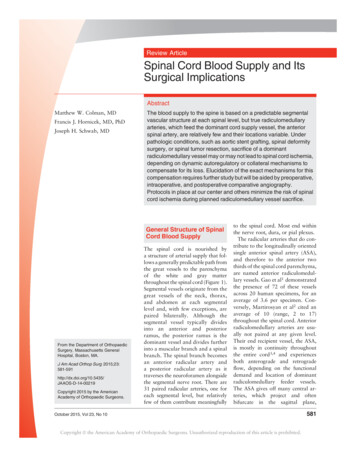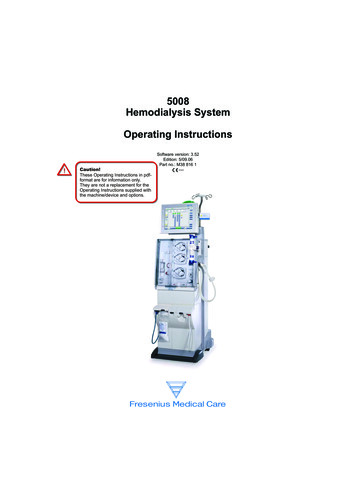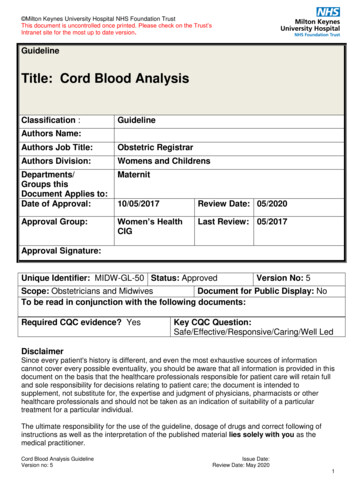
Transcription
Milton Keynes University Hospital NHS Foundation TrustThis document is uncontrolled once printed. Please check on the Trust’sIntranet site for the most up to date version.GuidelineTitle: Cord Blood AnalysisClassification :GuidelineAuthors Name:Authors Job Title:Obstetric RegistrarAuthors Division:Womens and ChildrensDepartments/Groups thisDocument Applies to:Date of Approval:Maternit10/05/2017Review Date: 05/2020Approval Group:Women’s HealthCIGLast Review: 05/2017Approval Signature:Unique Identifier: MIDW-GL-50 Status: ApprovedVersion No: 5Scope: Obstetricians and MidwivesDocument for Public Display: NoTo be read in conjunction with the following documents:Required CQC evidence? YesKey CQC Question:Safe/Effective/Responsive/Caring/Well LedDisclaimerSince every patient's history is different, and even the most exhaustive sources of informationcannot cover every possible eventuality, you should be aware that all information is provided in thisdocument on the basis that the healthcare professionals responsible for patient care will retain fulland sole responsibility for decisions relating to patient care; the document is intended tosupplement, not substitute for, the expertise and judgment of physicians, pharmacists or otherhealthcare professionals and should not be taken as an indication of suitability of a particulartreatment for a particular individual.The ultimate responsibility for the use of the guideline, dosage of drugs and correct following ofinstructions as well as the interpretation of the published material lies solely with you as themedical practitioner.Cord Blood Analysis GuidelineVersion no: 5Issue Date:Review Date: May 20201
Milton Keynes University Hospital NHS Foundation TrustThis document is uncontrolled once printed. Please check on the Trust’sIntranet site for the most up to date version.IndexGuideline Statement . Error! Bookmark not defined.Executive Summary. Error! Bookmark not defined.1.0Roles and Responsibilities: . 32.0Implementation and dissemination of document . 33.0Processes and procedures . 34.0Statement of evidence/references . 55.0Governance. 5Guideline Statement Provide a rationale for undertaking cord blood analysis.Reiterate important points to remember when taking cord blood.Outline situations which require cord blood analysis.Provide normal blood gas values for comparison.Executive SummaryUmbilical cord blood gas and acid base assessment provide information about a baby’s respiratoryand metabolic status. It is recommended in all high risk deliveries. The degree to which blood gasresults vary from normal limits helps staff to understand the effectiveness of organ function and theability of the baby to compensate for acute or chronic changes at the moment of birth.To understand the significance of these changes it is necessary to look at the normal values andlimits.To ensure that cord blood sampling is undertaken in line with the evidence-based practice, botharterial and venous cord pH, pO2, pCO2 and base deficit should be measured.Cord Blood Analysis GuidelineVersion no: 5Issue Date:Review Date: May 20202
Milton Keynes University Hospital NHS Foundation TrustThis document is uncontrolled once printed. Please check on the Trust’sIntranet site for the most up to date version.1.0Roles and Responsibilities:For use by midwives and obstetricians in order to make evidence based decisions when caring forlabouring women, whose babies fall under the criteria for Cord blood analysis.2.0Implementation and dissemination of documentThis Guideline is available on the Intranet and has followed the Guideline review process prior topublication3.0Processes and procedures3.1Rational for obtaining cord bloodPaired cord blood gases should not be taken routinely. They may be taken when there has beenconcern about the baby either in labour or immediately following birth.When to cut the umbilical cord has long been debated and the RCOG recommends that the time atwhich the cord is clamped should be recorded; “Timing needs to be based on clinical assessmentand the cord should not be clamped earlier than necessary.An additional clamp to facilitate double clamping of the cord, if indicated, should be available for allbirth settings.Cord blood MUST always be obtained in the following: All emergency caesarean sections and instrumental births Delivery for presumed ‘ fetal distress’ Shoulder dystocia If a FBS has been performed during labour Following birth if the baby’s condition is poor (low apgars to / less than 7) Significant meconium stained liquor present APH/Abruption Preterm birth Multiple pregnancy Pyrexia in labourNote:If baby is unexpectedly born with possible signs of neonatal compromise, admitted to NNU orpregnancy is complicated (e.g., preterm / stillborn / abruption / chorioamnionitis), send placenta forhistology.The neonatal and obstetric team will work together to explain as soon after the birth as possiblethe cord blood analysis results; and provide appropriate support and information to the parents.Cord Blood Analysis GuidelineVersion no: 5Issue Date:Review Date: May 20203
Milton Keynes University Hospital NHS Foundation TrustThis document is uncontrolled once printed. Please check on the Trust’sIntranet site for the most up to date version.3.2Method -Cord blood analysis should be assessed by collecting paired samples from the umbilicalartery (UA) and umbilical vein (UV) of a segment of cord that has been double clamped toisolate it from the placenta.The sample (segment of cord) must be at least 15cm long, it is important to ensure that thecord segment is full of blood, by milking the cord from the placenta if necessary beforeclamping.Using heparinised syringesTake blood from the artery first (reflects the fetal status) and then the vein (reflects thematernal-acid base status and placental function).Remove all air bubbles from the samples by gently rolling the syringe between the fingers.Analyse the samples as soon as possible after collection; if a delay is anticipated place thecapped syringes in ice or cold water.In the event of the blood gas analyser being out of order, the samples will be need to kept cool i.e.in cold water, ice or fridge until transported to the lab. They will require the baby's details on themincluding MRN therefore the baby will need to be registered. The biochemist should be informedthat the analyser is not functioning and that the samples are on their way to the lab. These willneed to be transported within 30 minutes. A datix should be generated regarding the faultyequipment.There are blood gas analysers in NNU and in Phase 1 Theatres which should be used for alltheatre cases but can also be used if the analyser on Labour Ward is out of order.3.3Results:Check results are compatible with one arterial and one venous sample by ensuring that the: Arterial pH is less than the venous pH (by at least a difference of 0.022units) andArterial pCO2 is greater than the venous pCO2(by at least a difference of 5.3mm Hg)All results should be recorded in mother’s and baby’s notes.The actual pH measurements can be taken at any time in the following 15-20 minutes,allowing birth attendants the opportunity to deal with the immediate needs of mother andbaby.3.3.1 Normal blood gas valuesAt TermpHUAUV7.10-7.387.20-7.44Cord Blood Analysis GuidelineVersion no: 5Base Excessmmol/L-9.0 to 1.8-7.7 to 1.9pO2 mm HgpCO2 mm Hg4.1 to 31.730.4 to 57.239.1 to 73.514.1 to 43.3Issue Date:Review Date: May 20204
Milton Keynes University Hospital NHS Foundation TrustThis document is uncontrolled once printed. Please check on the Trust’sIntranet site for the most up to date version.4.0Statement of evidence/referencesStatement of evidence:National Institute for Health and Clinical Excellence (NICE) (2016) Intrapartum care for healthywomen and babies Clinical guideline [CG190] London. NICENational Institute for Health and Clinical Excellence (NICE) Clamping of the Umbilical Cord andPlacental Transfusion (Scientific Impact Paper No. 14) London. NICE.References:Plymouth Perinatal Research Group (1994-2000) Umbilical Cord Blood Sampling & Expert DataCare. Available from: http://www.k2ms.comWong, L. & Maclennan. (2011). Gathering the evidence: Cord gases and placental histology forbirths with low Apgar scores. Australian and New Zealand Journal of Obstetrics and Gynaecology.51, 17-21.Harris, M., Beckley S.L., Garibaldi, J.M. et al. (1996). Umbilical cord gas analysis at the time ofdelivery. Midwifery.12:146-50.5.0Governance5.1 Record of changes to documentVersion number: 5Section AmendmentNumberDate:DeletionAdditionReason5.2 Consultation HistoryStakeholdersName/BoardMatronsArea ofExpertiseDateReceivedMay 2017CommentsEndorsed Yes/NoNo commentsYesHead of MidwiferyMay 2017No commentsYesConsultant Midwifeand MatronsConsultantsMay 2017No commentsYesMay 2017No commentsYesRegistrars/SHOand MidwivesMay 2017No commentsYesCord Blood Analysis GuidelineVersion no: 5Date SentIssue Date:Review Date: May 20205
Milton Keynes University Hospital NHS Foundation TrustThis document is uncontrolled once printed. Please check on the Trust’sIntranet site for the most up to date version.5.3 Audit and monitoringThis Guideline outlines the process for document development will be monitored on anongoing basis. The centralisation of the process for development of documents willenable the Trust to audit more effectively. The centralisation in recording documentsonto a Quality Management database will ensure the process is robust.AuditCriteriaToolTo monitorStatisticsthe amountof cordgasesprocessedand a Datixform to becompletedfor incidents(E.g. bloodgasanalyzer outof order)AuditLeadFrequencyof AuditResponsibleCommitteeMatronsBi-monthlyLabour WardForum, Riskmeetings,DivisionalmeetingsHow changeswill beimplementedAction plan tobe developedResponsibilityfor ActionsMatrons5.4 Equality Impact AssessmentThis document has been assessed using the Trust’s Equality Impact Assessment Screening Tool.No detailed action plan is required. Any ad-hoc incident which highlights a potential problem willbe addressed by the monitoring committee.AgeDisabilityRaceGenderReligion orBeliefSexualOrientationImpactDo different groups have different needs, experiences,issues and priorities in relation to the proposedGuideline?Is there potential for or evidence that the proposedGuideline will not promote equality of opportunity for alland promote good relations between different groups?Is there potential for or evidence that the proposedGuideline will affect different population groups differently(including possibly discriminating against certain groups)?Is there public concern (including media, academic,voluntary or sector specific interest) in potentialdiscrimination against a particular population group oNoNoNoCord Blood Analysis GuidelineVersion no: 5Issue Date:Review Date: May 20206
Milton Keynes University Hospital NHS Foundation TrustThis document is uncontrolled once printed. Please check on the Trust’sIntranet site for the most up to date version.Cord Blood Analysis GuidelineVersion no: 5Issue Date:Review Date: May 20207
The sample (segment of cord) must be at least 15cm long, it is important to ensure that the cord segment is full of blood, by milking the cord from the placenta if necessary before clamping. Using heparinised syringes - Take blood from the artery first (reflects the fetal status) and then the vein (reflects the
